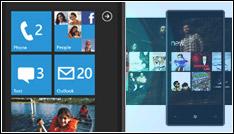Windows Phone 7 Released To Manufacturers

Microsoft’s upcoming smartphone operating system is headed for devices in time for the Christmas shopping season
Microsoft’s Windows Phone 7 reached its release-to-manufacturing milestone on 1 September. From here, the smartphone operating system will be released to Microsoft’s partners, who will integrate the software with their devices.
Microsoft plans to release Windows Phone 7 devices in time for the 2010 Christmas shopping season, and hopes that consumers will gravitate to the platform in place of either Apple iPhone or Google Android. In place of those competing platforms’ user interfaces, which offer grid-like pages of individual apps, Windows Phone 7 aggregates web content and applications into subject-specific Hubs such as “Office” and “Games”.
Thorough testing
“Windows Phone 7 is the most thoroughly tested mobile platform Microsoft has ever released,” Terry Myerson, corporate vice president of Windows Phone Engineering, wrote in a 1 September posting on The Windows Blog. “We had nearly ten thousand devices running automated tests daily, over a half million hours of active self-hosting use, over three and a half million hours of stress test passes, and eight and a half million hours of fully automated test passes.”
 When Windows Phone 7 reached its “technical preview” milestone in July, Myerson wrote on The Windows Blog that more than 1,000 Microsoft employees had tested the operating system for the past few months, specifically for metrics such as battery life, usability and network connectivity. At that point, thousands of prototype phones from Asus, LG Electronics and Samsung were being sent to developers.
When Windows Phone 7 reached its “technical preview” milestone in July, Myerson wrote on The Windows Blog that more than 1,000 Microsoft employees had tested the operating system for the past few months, specifically for metrics such as battery life, usability and network connectivity. At that point, thousands of prototype phones from Asus, LG Electronics and Samsung were being sent to developers.
Microsoft hopes those developers will build a robust ecosystem of mobile apps for the company’s Windows Phone Marketplace. In early August, Microsoft introduced a series of online tutorials demonstrating best practices for game- and app-building.
Windows Phone 7 will cost Microsoft nearly a half-billion dollars in marketing during the smartphone operating system’s initial rollout, according to Deutsche Bank analyst Jonathan Goldberg. “This is make-or-break for them. They need to do whatever it takes to stay in the game,” he told the blog TechCrunch on 26 August. “They don’t have to take share from Android or Apple, so long as they can attract enough consumers switching from feature phones.”
Goldberg estimated Microsoft’s marketing tab for the platform at $400 million (£260 million), on top of the already-substantial development costs for the platform, while suggesting that HTC, Samsung and LG Electronics remained the primary Windows Phone 7 handset manufacturers.
Market share decline
Microsoft’s previous smartphone operating system, Windows Mobile 6.5, was intended as a “placeholder” for the company’s mobile market share until the release of Windows Phone 7. However, Microsoft’s share continued to decline in the face of fierce competition from Apple and Google, forcing Microsoft chief executive Steve Ballmer to issue several mea culpas over the course of the past year.
“We missed a generation with Windows Mobile. We really did miss a release cycle,” Ballmer told the audience during his 12 July keynote at Microsoft’s Worldwide Partner Conference. However, he promised, “We will give you a set of Windows-based devices that people will be proud to carry.”
At that same conference, one of his lieutenants suggested that the smartphone game was still in its early innings.
“The phone is going through a massive inflection point,” Andy Lees, senior vice president of Microsoft’s Mobile Communications Business, told the audience during his own 13 July keynote address. “There’s immense competition but, in many respects, things are just beginning.”